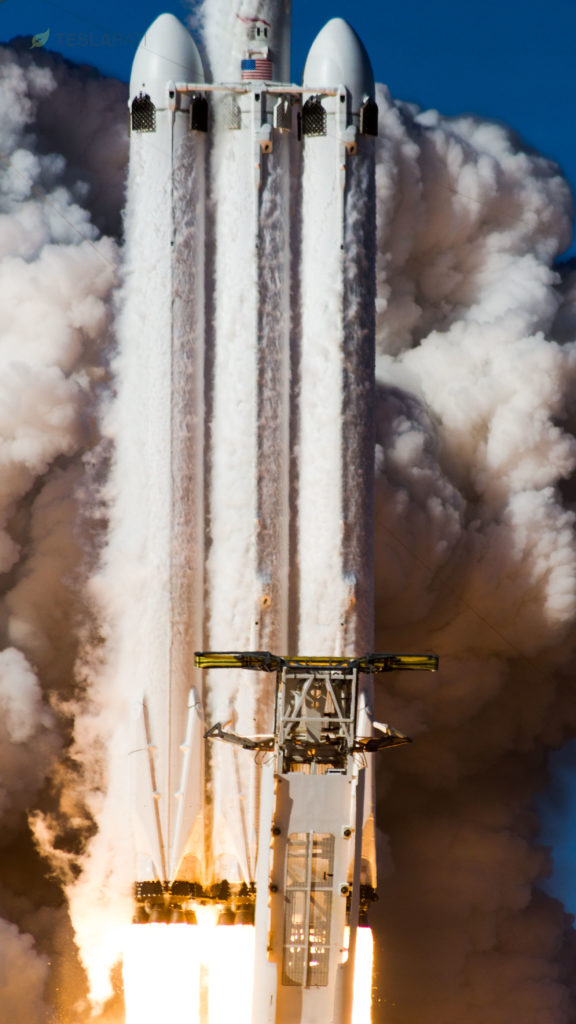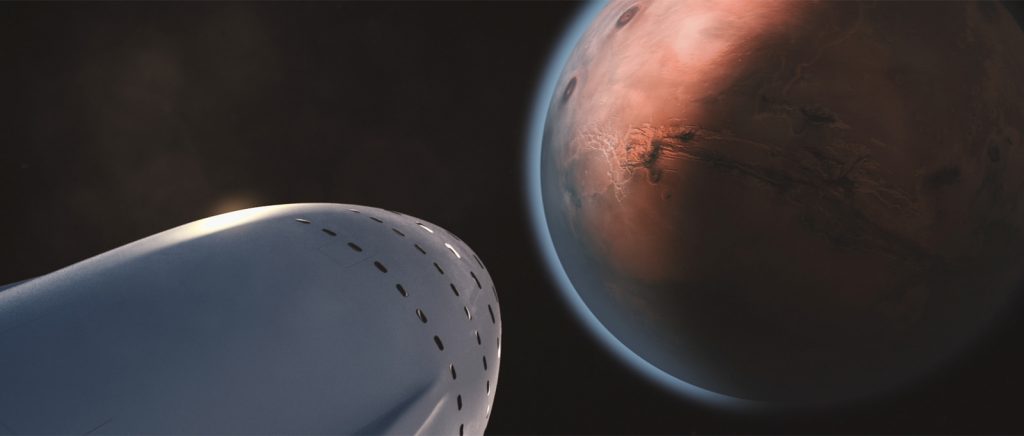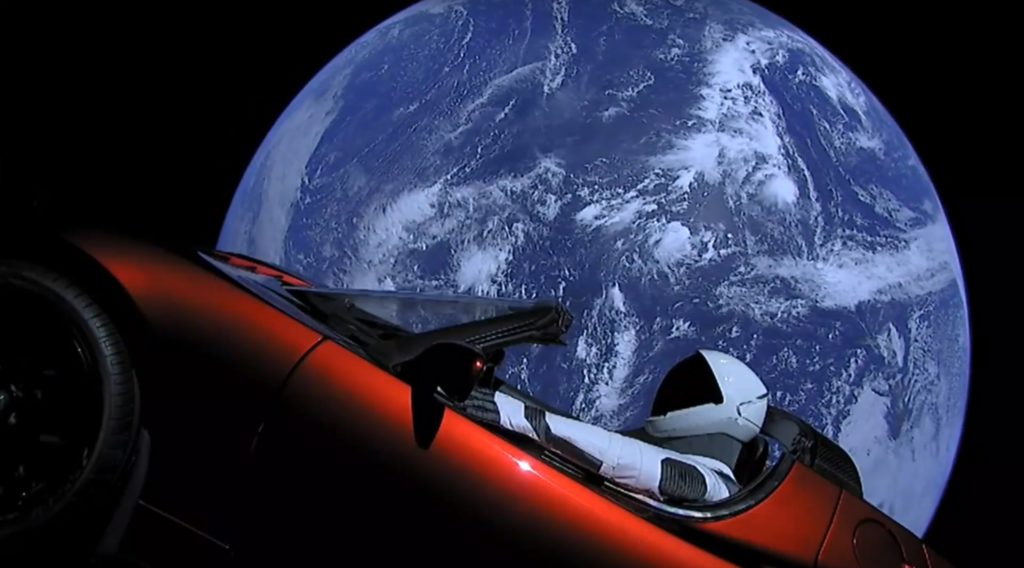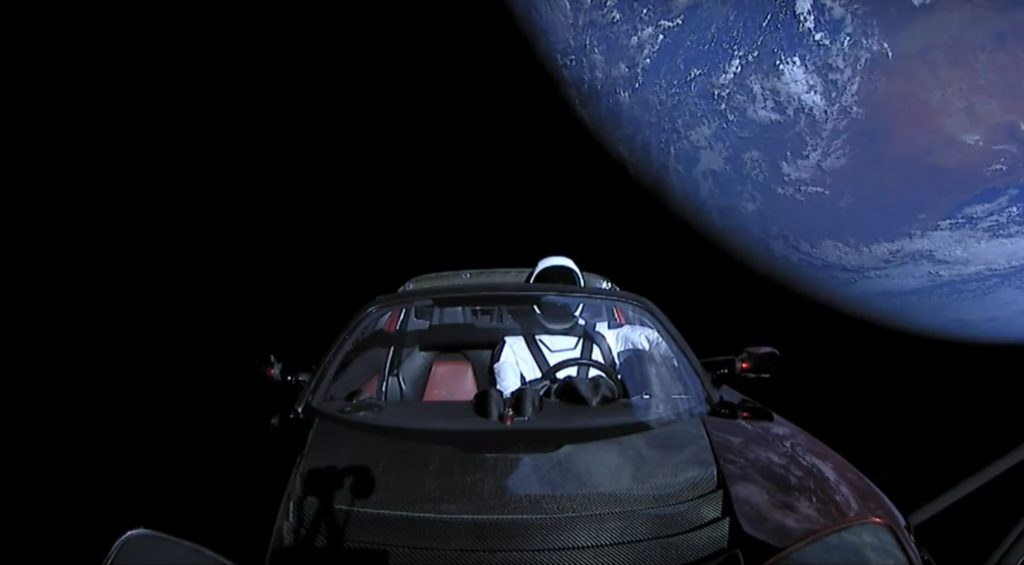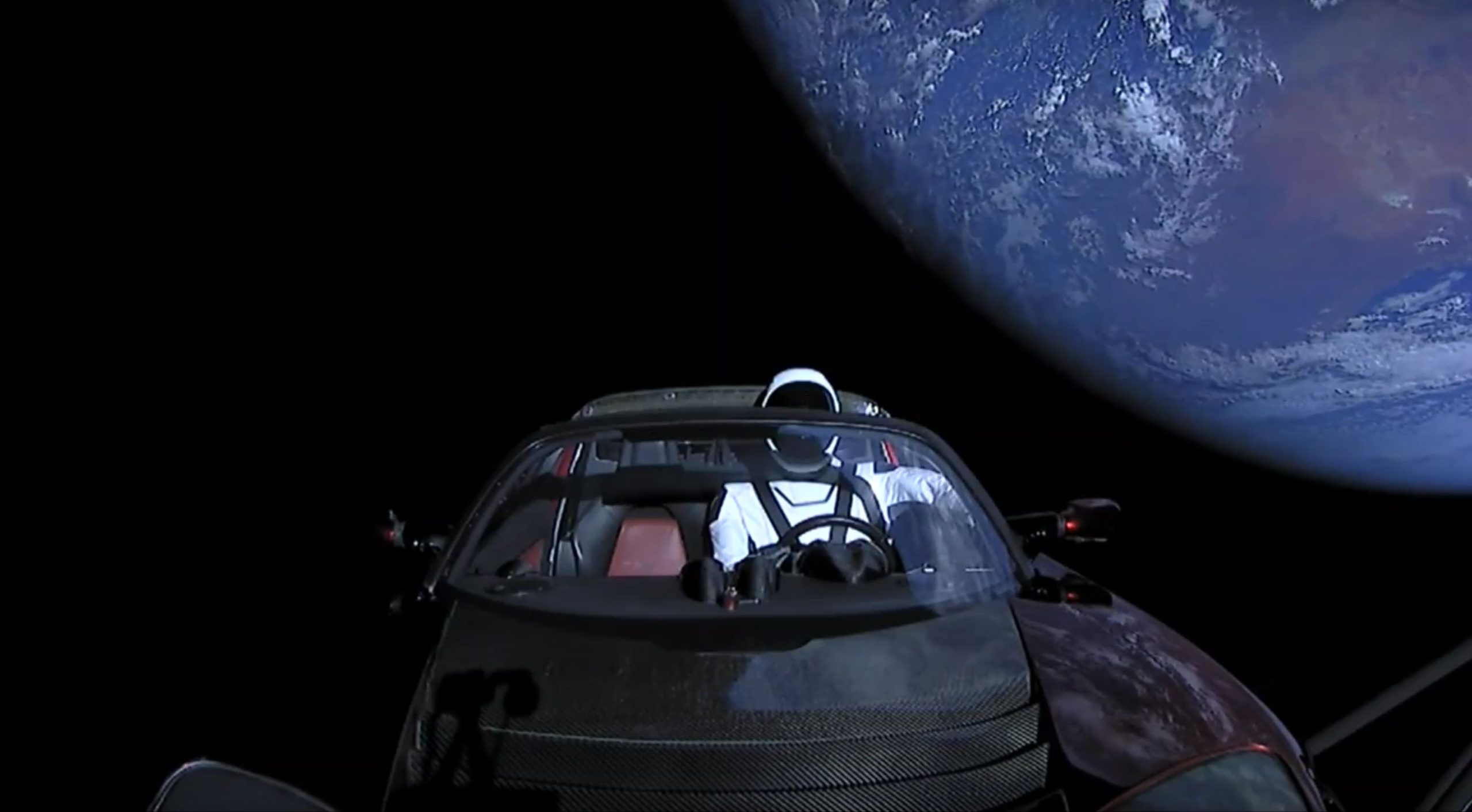
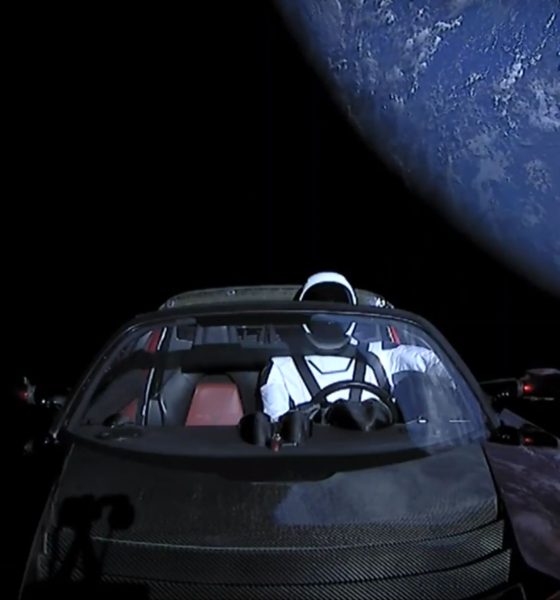
News
What will happen to Elon Musk’s Tesla on its space journey to Mars?
SpaceX has completed the last crucial step of Falcon Heavy’s inaugural test flight after successfully launching Elon Musk’s Tesla Roadster out of Earth’s orbit, on a trajectory into deep space. But what will happen to the car and ‘Starman’ as it makes its long journey to Mars? Let us explore the details.
Although Elon Musk indicated that the Tesla had been placed in an orbit that would nearly extend to the beginnings of the solar system’s first asteroid belt (on average more than 150 million miles away from Earth’s orbit), SpaceX updated that orbit estimate about 24 hours later and confirmed that the orbit was considerably closer to Mars’ orbit than the asteroid belt beyond the Red Planet.

Starman gives one final farewell to Earth as he departs for deep space aboard Musk’s Tesla Roadster. (SpaceX)
Understandably, the ultimate destination and state of the Roadster have been the source of an array of questions from those less familiar with interplanetary travel and orbital mechanics – most people.
How exactly does space travel work?
Before delving into the details, it’s crucial that I try to give everyone equal footing in the form of a basic understanding of what, how, and whens of spaceflight. To reach orbit, Falcon Heavy launched its Tesla payload horizontally. Once it rose vertically above the majority of Earth’s atmosphere, the rocket angled over until it was essentially thrusting parallel to Earth’s surface. Think of it like spinning a ball on a string: only after a certain speed will the ball successfully spin in a circle – spin too slow and the ball will simply fall. Reaching Earth orbit is very similar in concept: Falcon Heavy boosts the upper stage above Earth’s atmosphere, and the upper stage ignites and gains as much horizontal speed as possible.
All this time, both it and its Tesla payload are being pulled down by Earth’s gravity, but at a certain speed (8 kilometers per second, or ~18,000 mph), the rocket and its payload end up going faster around the Earth than its gravity can pull them down. A famous analogy can be found in a simple tennis ball: thrown normally, the ball will arc over and eventually fall to the ground. However, if a ball is thrown fast enough (and was also able to avoid being incinerated by friction against the atmosphere), one can imagine the ball going over the horizon, traveling around the Earth, and coming right back to the thrower.

Elon Musk walks among his recovered Falcon Heavy boosters at LZ-1 and 2. (Elon Musk)
Throwing a ball (or spaceship) into orbit
Amazingly, this becomes a far more reasonable proposition when dealing with asteroids, comets, and moons with much light gravity than Earth’s “1G.” For example, on Mars’ tiny moon Phobos, an astronaut could very nearly escape from the moon by running, and could almost effortlessly throw a ball fast enough to orbit Phobos (a blistering 25 mph would be required). Earth is just like that, just much, much, much larger, and with a thick atmosphere that both keeps us, humans, alive and also makes it quite a bit more difficult for us to get into orbit.
Back to Earth orbit. The first point of stability (when you are going faster forward than the Earth can pull you down) is called “low Earth orbit,” (LEO) being roughly the lowest height and velocity necessary to stably orbit the Earth. This is approximately where the International Space Station (ISS) is located (~ 250 miles above). Famously, astronauts and satellites at this altitude travel around the Earth once every 90 minutes, half in pure sunlight, half in the darkness of Earth’s own shadow – essentially a special sunrise and sunset every three-quarter of an hour.

Mars’ largest moon Phobos captured at the edge of the planet’s limb. Phobos is less than 15 miles in diameter. (ESA/Mars Express)
Now, expand that model of Earth and the Roadster in orbit around it to the entire solar system. In this model, Earth and all other objects are orbiting the Sun at different distances and speeds, like different bands of the same tree ring. The solar system is massive, however, and thus everything has to be scaled up: for example, the Earth orbits the Sun at 30 kilometers per second (~70,000 mph), nearly four times faster than our humble Tesla in LEO.
Remember: when orbiting Earth, objects are still under the firm hold of the planet’s gravity, but merely moving so fast that they are in a constant state of freefall. Take away the air, and being on the ISS is akin to skydiving, but if the skydive never ended. To truly escape Earth’s gravity and head to the Moon, Mars, or beyond, a rocket needs to go even faster still. In the case of the Roadster, this meant first speeding up to 8 km/s to reach a stable orbit around Earth, followed several hours later by one final burn that gave the payload another 3-4 km/s of speed. On the scale of the solar system, Roadster’s journey away from Earth can be thought of like, well, a Roadster making its way to the top of a steep hill. After climbing to the top, the Roadster is nearly out of energy but has just enough to accelerate as it begins its way down the other side. About six hours after launch, the rocket’s upper stage successfully crested the summit of Earth’s gravitational hill before rocketing down the other side, on its way to deep space, Mars, and beyond.
In essence, the rocket moved Musk’s Tesla from an orbit around Earth to an orbit around the Sun itself. Just as Earth takes 365 days (a year) to travel once around the Sun, the Roadster will complete an orbit of the sun every once in awhile, likely closer to the two Earth years it takes for Mars to complete its orbit. Similarly, evidenced by Earth and all the other planets in the solar system, orbiting the sun is typically very stable – humans do not exactly live in fear of the Earth falling into the sun, we just keep going around and around. Like the planets, Musk’s Roadster will almost certainly remain in its current orbit for millions of years – maybe even a billion years – quietly completing an orbit around the sun every two or so years for what is effectively an eternity on a human scale. Eventually, it’s possible that the Roadster and Starman will be pulled over time by the gravity of Earth in such a way that it reenters Earth’s atmosphere and burns up, but that is unlikely to happen for thousands of millennia.
Where is the Roadster headed?
The graphic tweeted by Musk serves as a good initial explanation of complex terms used to describe orbital mechanics. Because it is not circular, the orbit is known as elliptical, while the points closest to (perihelion) and furthest from (aphelion) the Sun also have their special names. The AU mentioned in the graphic refers to astronomical units, a standard measurement based upon the average distance between the Earth and the Sun – approximately 93 million miles. For comparison, a full trip around the Earth’s equator is a little less than 25,000 miles. Space is unfathomably immense.
Third burn successful. Exceeded Mars orbit and kept going to the Asteroid Belt. pic.twitter.com/bKhRN73WHF
— Elon Musk (@elonmusk) February 7, 2018
- Falcon Heavy explodes off of Pad 39A in a spectacle of fire, Roadster in tow. (Tom Cross)
- The Roadster’s orbit will reach out on one end as far as Mars, SpaceX’s ultimate destination as a company. (SpaceX)
Falcon Heavy’s upper stage appears to have simply burned until it ran out of fuel, and managed with the far end of its orbit at about 1.61 astronautical units (~250 million km) is considerably less than Musk’s pre-launch press conference suggestion that the Roadster was expected to end up in an orbit of 380 to 450 million kilometers.
Musk: If the third burn goes as we hope, the Tesla will get as far away as 380 to 450 million km from Earth.
— Eric Berger (@SciGuySpace) February 5, 2018
Is the Roadster going to Mars?
Sadly, the answer is a hard “no.” At most, the Tesla might have been sent into an orbit around the sun (heliocentric orbit) with a very close approach to Mars – a flyby, so to speak. It appears that SpaceX managed to get quite close to that original goal, and it is entirely possible that Starman’s Roadster could pass close to Mars at points along its orbit, although there will be no way to capture or transmit images from the Roadster.

While there will be no cameras to capture it, it looks like Starman could actually – one day – pass close to the Red Planet on his billion year journey. (SpaceX)
Perhaps most importantly, to launch the Roadster into such a high orbit, SpaceX had to ensure that the rocket’s upper stage could coast for multiple hours in Earth orbit and still be able to precisely reignite its Merlin Vacuum (MVac) engine for a final burn. By successfully accomplishing precisely that, SpaceX has taken a huge step towards being able to compete with the United Launch Alliance for all government and defense-related launch contracts, even those requiring direct placement into geostationary orbit (GEO), versus a slower but more common geostationary transfer orbit (GTO). Not coincidentally, that capability also means that SpaceX can efficiently send payloads beyond Earth orbit, as they have now done for the first time with Musk’s Tesla Roadster.
How long will it take?
Because the Roadster is not actually going to any planets, moons, or asteroids, it will never reach them. However, the electric car’s newfound orbital home means that it will at least be far, far from Earth – at points, it’s trajectory will cross closest to the orbits of Mars and Earth. It will take a minimum of several months for the Roadster to reach those distances, even at its blistering speed of 12 kilometers per second relative to Earth. Jonathan McDowell, a practicing astronomer, estimated that the Roadster would pass Mars orbit – to be clear, not arriving at Mars, simply reaching the same distance away from the Sun as Mars orbits – in July 2018, approximately five months from today.
Corrected orbital data for the Roadster: 0.99 x 1.71 AU x 1.1 deg
C3 = 12.0, passes orbit of Mars Jul 2018, aphelion November— Jonathan McDowell (@planet4589) February 8, 2018
What’s going to happen to Starman and the Roadster?
Soaring through the hard vacuum of deep space, not a whole lot can be expected to happen to Elon Musk’s Tesla Roadster and Starman. As mentioned, the high heliocentric orbit it was placed in will be incredibly stable, likely allowing the car to remain in deep space for tens of millions of years. Now, that is not to say that future human explorers millions of years from now would recognize whatever remained – deep space is characterized by a relatively extreme radiation environment that will not be kind to many components that make up the Roadster’s structure. Carbon fiber, plastic, leather, and paint all contain organic components that will be assaulted by an environment far harsher than that in and around Earth.
- Elon’s Tesla Roadster and his astronaut stand-in. (Elon Musk)
- . . . . . . . . yep. This is a thing, now. (SpaceX)
Still, hyperbolic claims that “Radiation Will Tear Elon Musk’s Rocket Car to Bits in a Year” are ridiculously exaggerated. Vacuum is characterized by the absence of anything, and that includes all conceivable methods of erosion. While high energy radiation found in deep space can and likely will shred the Tesla’s structural integrity and eventually bleach or discolor the car, the Roadster will be perfectly suspended in microgravity (basically zero gravity) conditions with almost no chance whatsoever of impacts by even tiny space debris like micrometeorites. If an aspiring car collector tried to recover the eccentric and historic trophy from space in several centuries/millennia, Roadster would very likely fall to pieces or even crumble to dust when moved or placed in an environment with any significant gravity. But, it will almost without a doubt retain its recognizable shape almost indefinitely, at least on a human scale. Starman can be expected to react very similarly.
hyperbolic claims that “Radiation Will Tear Elon Musk’s Rocket Car to Bits in a Year” are ridiculously exaggerated.
Finally, it appears that SpaceX has not installed any method of power generation or communication on Starman’s ride, meaning that humans likely saw their last views of the vehicle after SpaceX cut the live feed to Starman. This sadly means that there will be no photo ops with Starman soaring past Mars or exploring the asteroid belt, although that option will certainly be reserved for any future eccentric, Muskian test payloads.
Why does sending a car into deep space matter?
Ultimately, this final success is an invaluable cherry on top of what was already a stunning achievement. Without a single scrubbed launch attempt or unintended hold during the final countdown, SpaceX’s first launch of what is now the most capable operational rocket in the world was a perfect success in almost all regards. Although the massive rocket’s center booster failed to land aboard the drone ship Of Course I Still Love You (OCISLY) due to an apparent shortage of the chemical components used to reignite the booster’s engines, both side boosters were recovered on land with what can only be described as well-oiled expertise. Meanwhile, the rocket simply survived the launch in general, didn’t destroy the pad, successfully tested its unproven side booster separation mechanism, and launched an eccentric payload into the highest orbit yet achieved by the commercial launch company.
- It’s easy to understand why Musk himself laughed about Roadster looking very much like CGI. (SpaceX)
- Is this real life? Who knows anymore. (SpaceX)
- . . . . . . . . yep. This is a thing, now. (SpaceX)
In the case of Elon Musk, it certainly appears that it is possible to – at least once and awhile – have one’s cake and eat it too. Follow along live as launch photographer Tom Cross and I cover these exciting proceedings as close to live as possible.
Teslarati – Instagram – Twitter
Tom Cross – Twitter
Eric Ralph – Twitter

Elon Musk
Elon Musk’s xAI bets $20B on Mississippi with 2GW AI data center project
The project is expected to create hundreds of permanent jobs, dramatically expand xAI’s computing capacity, and further cement the Mid-South as a growing hub for AI infrastructure.
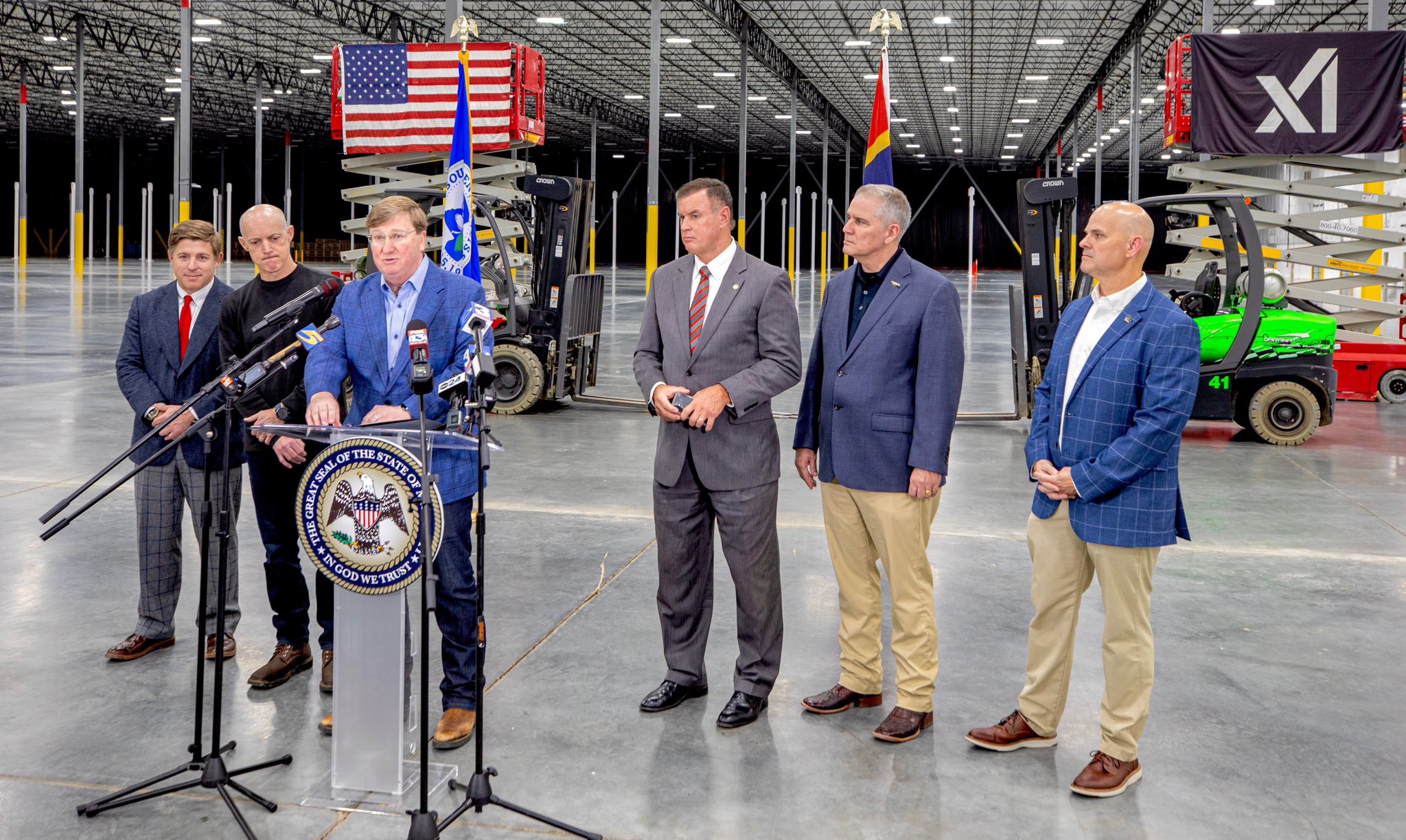
Elon Musk’s xAI plans to pour more than $20 billion into a massive new data center campus in Southaven, Mississippi, marking the largest single economic development project in the state’s history.
The project is expected to create hundreds of permanent jobs, dramatically expand xAI’s computing capacity, and further cement the Mid-South as a growing hub for AI infrastructure.
xAI goes MACROHARDRR in Mississippi
xAI has acquired and is retrofitting an existing facility in Southaven to serve as a new data center, which will be known as “MACROHARDRR.” The site sits near a recently acquired power plant and close to one of xAI’s existing data centers in Tennessee, creating a regional cluster designed to support large-scale AI training and inference.
Once completed, the Southaven facility is expected to push the company’s total computing capacity to nearly 2 GW, placing it among the most powerful AI compute installations globally. The data center is scheduled to begin operations in February 2026.
Gov. Tate Reeves shared his optimism about the project in a press release. “This record-shattering $20 billion investment is an amazing start to what is sure to be another incredible year for economic development in Mississippi. Today, Elon Musk is bringing xAI to DeSoto County, a project that will transform the region and bring amazing opportunities to its residents for generations. This is the largest economic development project in Mississippi’s history,” he said.
xAI’s broader AI ambitions
To secure the investment, the Mississippi Development Authority approved xAI for its Data Center Incentive program, which provides sales and use tax exemptions on eligible computing hardware and software. The City of Southaven and DeSoto County are also supporting the project through fee-in-lieu agreements aimed at accelerating development timelines and reducing upfront costs.
Founded in 2023 by Elon Musk, xAI develops advanced artificial intelligence systems focused on large-scale reasoning and generative applications. Its flagship product, Grok, is integrated with the social media platform X, alongside a growing suite of APIs for image generation, voice, and autonomous agents, including offerings tailored for government use.
Elon Musk highlighted xAi’s growth and momentum in a comment about the matter. “xAI is scaling at an immeasurable pace — we are building our third massive data center in the greater Memphis area. MACROHARDRR pushes our Colossus training compute to ~2GW – by far the most powerful AI system on Earth. This is insane execution speed by xAI and the state of Mississippi. We are grateful to Governor Reeves for his support of building xAI at warp speed,” Musk said.
Elon Musk
Tesla AI Head says future FSD feature has already partially shipped

Tesla’s Head of AI, Ashok Elluswamy, says that something that was expected with version 14.3 of the company’s Full Self-Driving platform has already partially shipped with the current build of version 14.2.
Tesla and CEO Elon Musk have teased on several occasions that reasoning will be a big piece of future Full Self-Driving builds, helping bring forth the “sentient” narrative that the company has pushed for these more advanced FSD versions.
Back in October on the Q3 Earnings Call, Musk said:
“With reasoning, it’s literally going to think about which parking spot to pick. It’ll drop you off at the entrance of the store, then go find a parking spot. It’s going to spot empty spots much better than a human. It’s going to use reasoning to solve things.”
Musk said in the same month:
“By v14.3, your car will feel like it is sentient.”
Amazingly, Tesla Full Self-Driving v14.2.2.2, which is the most recent iteration released, is very close to this sentient feeling. However, there are more things that need to be improved, and logic appears to be in the future plans to help with decision-making in general, alongside other refinements and features.
On Thursday evening, Elluswamy revealed that some of the reasoning features have already been rolled out, confirming that it has been added to navigation route changes during construction, as well as with parking options.
He added that “more and more reasoning will ship in Q1.”
🚨 Tesla’s Ashok Elluswamy reveals Nav decisions when encountering construction and parking options contain “some elements of reasoning”
More uses of reasoning will be shipped later this quarter, a big tidbit of info as we wait v14.3 https://t.co/jty8llgsKM
— TESLARATI (@Teslarati) January 9, 2026
Interestingly, parking improvements were hinted at being added in the initial rollout of v14.2 several months ago. These had not rolled out to vehicles quite yet, as they were listed under the future improvements portion of the release notes, but it appears things have already started to make their way to cars in a limited fashion.
Tesla Full Self-Driving v14.2 – Full Review, the Good and the Bad
As reasoning is more involved in more of the Full Self-Driving suite, it is likely we will see cars make better decisions in terms of routing and navigation, which is a big complaint of many owners (including me).
Additionally, the operation as a whole should be smoother and more comfortable to owners, which is hard to believe considering how good it is already. Nevertheless, there are absolutely improvements that need to be made before Tesla can introduce completely unsupervised FSD.
Elon Musk
Tesla’s Elon Musk: 10 billion miles needed for safe Unsupervised FSD
As per the CEO, roughly 10 billion miles of training data are required due to reality’s “super long tail of complexity.”

Tesla CEO Elon Musk has provided an updated estimate for the training data needed to achieve truly safe unsupervised Full Self-Driving (FSD).
As per the CEO, roughly 10 billion miles of training data are required due to reality’s “super long tail of complexity.”
10 billion miles of training data
Musk comment came as a reply to Apple and Rivian alum Paul Beisel, who posted an analysis on X about the gap between tech demonstrations and real-world products. In his post, Beisel highlighted Tesla’s data-driven lead in autonomy, and he also argued that it would not be easy for rivals to become a legitimate competitor to FSD quickly.
“The notion that someone can ‘catch up’ to this problem primarily through simulation and limited on-road exposure strikes me as deeply naive. This is not a demo problem. It is a scale, data, and iteration problem— and Tesla is already far, far down that road while others are just getting started,” Beisel wrote.
Musk responded to Beisel’s post, stating that “Roughly 10 billion miles of training data is needed to achieve safe unsupervised self-driving. Reality has a super long tail of complexity.” This is quite interesting considering that in his Master Plan Part Deux, Elon Musk estimated that worldwide regulatory approval for autonomous driving would require around 6 billion miles.
FSD’s total training miles
As 2025 came to a close, Tesla community members observed that FSD was already nearing 7 billion miles driven, with over 2.5 billion miles being from inner city roads. The 7-billion-mile mark was passed just a few days later. This suggests that Tesla is likely the company today with the most training data for its autonomous driving program.
The difficulties of achieving autonomy were referenced by Elon Musk recently, when he commented on Nvidia’s Alpamayo program. As per Musk, “they will find that it’s easy to get to 99% and then super hard to solve the long tail of the distribution.” These sentiments were echoed by Tesla VP for AI software Ashok Elluswamy, who also noted on X that “the long tail is sooo long, that most people can’t grasp it.”
